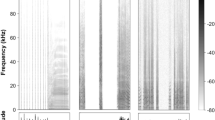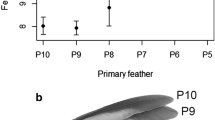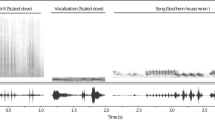Summary
Females of the digger wasp Liris niger Fabr. hunt crickets to provide food for their offspring by running with high velocity on the ground (>20–50 cm/s). Crickets are able to detect the running wasps by the air particle movement generated by the predator. We measured signals produced by running wasps using a microphone sensitive to air particle velocity. The wasps generated single air puffs with peak air particle velocities of 1–2 cm/s measured close to the running wasp. We measured frequency spectra of the signals containing only components below 50 Hz, with increasing intensities towards lower frequencies, especially below 10 Hz.
We measured the air particle movement generated by artificially moved wasps, crickets or a styrofoam dummy of similar size to investigate the effect of velocity and shape of the moving object upon the composition of the signal. The velocity of movement appeared to be important for the intensity and frequency composition of the air particle movement. The shape of the moved body had an influence on the intensity but only little effect on the frequency spectrum. Measurements with a thermistor anemometer showed that a moving object caused air currents lasting longer than 100 ms after passing or approaching the probe. The air particle movements generated by hunting wasps are entirely sufficient with respect to intensity and frequency range to be registered by the filiform hair sensilla upon the cerci of crickets.
Similar content being viewed by others
References
Bennet-Clark HC (1984) A particle velocity microphone for the song of small insects and other acoustic measurements. J Exp Biol 108:459–463
Camhi JM, Tom W, Volman S (1978) The escape behavior of the cockroach Periplaneta americana. II. Detection of natural predators by air displacement. J Comp Physiol 128:203–212
Edmunds M (1972) Defensive behaviour in Ghanaian praying mantids. J Linn Soc (Zool) 51:1–32
Gnatzy W, Heußlein R (1986) Digger wasp against crickets. I. Receptors involved in the antipredator strategies of the prey. Naturwissenschaften 73:212–215
Gnatzy W, Tautz J (1980) Ultrastructure and mechanical properties of an insect mechanoreceptor: Stimulus-transmitting structures and sensory apparatus of the cereal filiform hairs of Gryllus. Cell Tissue Res 213:441–463
Gnatzy W, Anton S, Thier S (1989) Digger wasp against cricket: Prey recognition and prey selection. In: Erber J, Menzel R, Pflüger HJ, Todt D (eds) Neuronal mechanisms of behavior. Georg Thieme, Stuttgart New York, p 214
Kämper G (1984) Abdominal ascending interneurons in crickets: responses to sound at the 30-Hz calling-song frequency. J Comp Physiol A 155:507–520
Kämper G, Dambach M (1979) Communication by infrasound in a non-stridulating cricket. Naturwissenschaften 66:530
Kämper G, Dambach M (1981) Response of the cercus-to-giant interneuron system in crickets to species-specific song. J Comp Physiol 141:311–317
Kämper G, Dambach M (1985) Low-frequency airborne vibrations generated by crickets during singing and aggression. J Insect Physiol 31:925–929
Kanou M, Shimozawa T (1984) A threshold analysis of cricket cereal interneurons by an alternating air-current stimulus. J Comp Physiol A 154:357–365
Markl H, Tautz J (1975) The sensitivity of hair receptors in caterpillars of Barathra brassicae L. (Lepidoptera, Noctuidae) to particle movement in a sound field. J Comp Physiol 99:79–87
Mendenhall B, Murphey RK (1974) The morphology of cricket giant interneurons. J Neurobiol 5:565–580
Plummer MR, Camhi JM (1981) Discrimination of sensory signals from noise in the escape system of the cockroach: the role of wind acceleration. J Comp Physiol 142:347–357
Sandow JD, Bailey WJ (1978) An experimental study of defensive stridulation in Mygalopsis ferruginea Redtenbacher (Orthoptera: Tettigoniidae). Anim Behav 26:1004–1011
Schmitz B, Scharstein H, Wendler G (1982) Phonotaxis in Gryllus campestris L. (Orthoptera, Gryllidae). I. Mechanism of acoustic orientation in intact female crickets. J Comp Physiol 148:431–444
Shimozawa T, Kanou M (1984) Varieties of filiform hairs — range fractionation by sensory afférents and cereal interneurons of a cricket. J Comp Physiol A 155:485–493
Steiner AL (1968) Behavioural interactions between Liris nigra Van der Linden (Hymenoptera, Sphecidae) and Gryllus domesticus L. (Orthoptera, Gryllidae). Psyche 75:256–273
Tautz J (1977) Reception of medium vibration by thoracal hairs of caterpillars of Barathra brassicae L. (Lepidoptera, Noctuidae). I. Mechanical properties of the receptor hairs. J Comp Physiol 118:13–31
Tautz J (1979) Reception of particle oscillation in a medium — an unorthodox sensory capacity. Naturwissenschaften 66:452–461
Tautz J, Markl H (1978) Caterpillars detect flying wasps by hairs sensitive to airborne vibration. Behav Ecol Sociobiol 4:101–110
Thorson J, Weber T, Huber F (1982) Auditory behavior of the cricket. II. Simplicity of calling-song recognition in Gryllus, and anomalous phonotaxis at abnormal carrier frequencies. J Comp Physiol 146:361–378
Author information
Authors and Affiliations
Rights and permissions
About this article
Cite this article
Gnatzy, W., Kämper, G. Digger wasp against crickets. II. An airborne signal produced by a running predator. J Comp Physiol A 167, 551–556 (1990). https://doi.org/10.1007/BF00190826
Accepted:
Issue Date:
DOI: https://doi.org/10.1007/BF00190826




